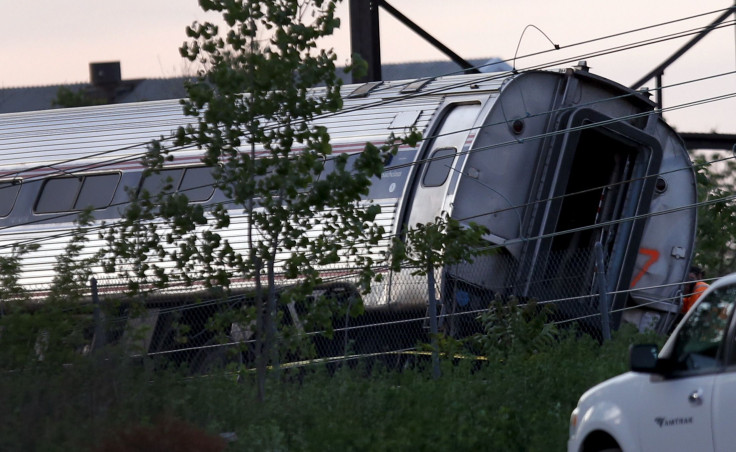Amtrak Train Engineer Told Investigators He Applied Emergency Brake At Over 100 Mph Speed Before Derailment

The engineer of the Amtrak train that derailed in Philadelphia, Pennsylvania, last May moved the throttle to the maximum speed and then applied the emergency brake, according to a transcript of his interview with federal investigators. The derailment, which killed eight people and injured about 200 others, is considered the worst train disaster in the U.S. in decades.
Brandon Bostian, in his initial interview to investigators after the accident, said he did not remember the crash. But in his second interview last November, Bostian gave a clear picture of what he believes happened seconds before the train went off track. He also warned the investigators that his recollection of the account had “several gaps” and he only remembered “a couple of prominent scenes” since the May 2015 interview, the Associated Press (AP) reported Monday.
Bostian told the investigators that he remembers pushing the throttle to speed the train in an 80 mph zone after first thinking the limit there was 70 mph. After he realized that the train was about to derail, Bostian said he tightly held the controls and thought, "Well, this is it, I'm going over," the AP reported, citing the transcripts.
"Once I pushed the throttle forward in an attempt to bring the train up to 80 miles an hour, I don't have any other memories until after the train was already in the curve," the engineer reportedly said in the November interview. He suffered a head injury in the crash.
Bostian told the investigators, according to the AP, that his practice for speeding the trains is to "gradually increase the throttle. I don't slam it all the way open when I'm going slow. But if you're going kind of fast, it's okay to slam it open. But I typically accelerate in full throttle and then back off as I approach the maximum speed."
As per the train’s data recorder, Bostian moved the throttle to full and held it there for about 30 seconds at about a mile and a half before the Frankford Junction curve, one of the sharpest in Amtrak's Northeast Corridor. The train reportedly reached a speed of about 95 mph.
Bostian then lowered the throttle a bit for two seconds before again applying it to full and holding it for another 20 seconds. He applied the emergency brake at a speed of 106 mph, three seconds before the train derailed. This reduced the speed to 102 mph throwing four of the train's seven cars and its locomotive off the track. The speed limit for the curve is 50 mph, and the limit for the stretch of track before the sharp curve is 80 mph.
Bostian reportedly said nighttime makes it difficult to see the beginning of the curve. However, there are visual cues marked up the way, including track signals and a nearby elevated subway bridge where he said he would normally start braking to bring the train down to 50 mph. He added that he did not look for speed restriction signs because they are sometimes missing or wrong.
"As that track curves to the left, it kind of, you're looking into somewhat of a black abyss," Bostian said, the AP reported.
Prior to the accident, Bostian was concerned about a train from Philadelphia's SEPTA transit system whose engineer was injured after a projectile — a rock or a bullet — broke the train’s windshield. He admitted that he was not concerned about his train being targeted with rocks, but he was worried that people might be on the tracks trying to respond to the incident and wanted to make sure everyone knew his train was approaching, Politico reported. Bostian said he was "slightly" concerned that his train might also get hit, but that he was "really concerned for the SEPTA engineer."
Officials have described Bostian as cooperative for his role in the investigation.
On Thursday, the National Transportation Safety Board’s information on the investigation stated that there were no faulty components of the railroad tracks involving an Amtrak train's derailment. While lawmakers and federal officials have considered various explanations for the incident, little or no evidence has emerged that a technical problem led to the accident. Last June, the NTSB also ruled out one of the primary ways human error could have resulted into the crash.
© Copyright IBTimes 2025. All rights reserved.






















